buy clomid 100mg twins 6 February 2020
purchase isotretinoin There are frequent comments that folio 77r represents medieval elements in the cosmological sense, but as you can see from my recent blog, I’m somewhat skeptical. There are five openings and two of the outflows are almost the same. Plus, they could be phlegm/bile/blood or various kinds of weather (hail, wind, rain, snow). But, even those ideas didn’t completely satisfy me, so I kept trying to think of others and here is an additional possibility….
A Different Interpretation
I’ve blogged about VMS folio 77r a few times and if you read the more recent ones, you may have noticed that I have never been completely convinced that these pipes were meant to be earth, water, air, and fire. Maybe they represent various outflows of alchemical heating and condensing processes:
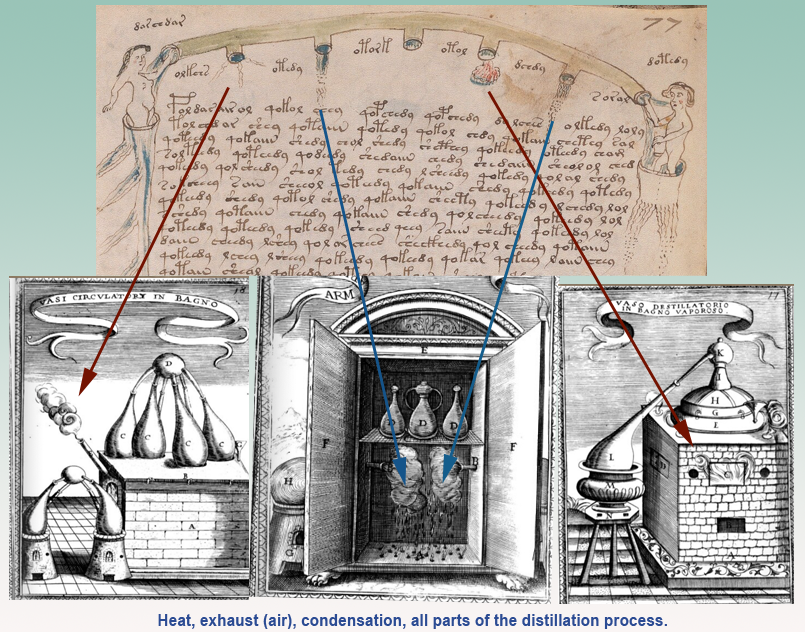
In other words, instead of earth, water, air, and fire (except in the metaphorical sense in which most alchemical processes were expressed at the time), this might be heat, exhaust, and either two instances of condensation, or possibly one instance of boiling and the other of condensation, since two of the VMS outflows are very similar but not exactly the same.
Many alchemical images have been related to the VMS in one way or another over the decades. Not surprisingly, since many alchemical manuscripts are enigmatic and highly symbolic.
I’ve blogged a few distillation images myself, and the two big bladder-like things have always reminded me of distillation vessels, but I couldn’t decide exactly what they might be. It was bi3mw’s post #70 on the Alchemical Symbolism thread that motivated me to go back through my notes and think about it again. Now I think these bladders might represent the sublimation process:
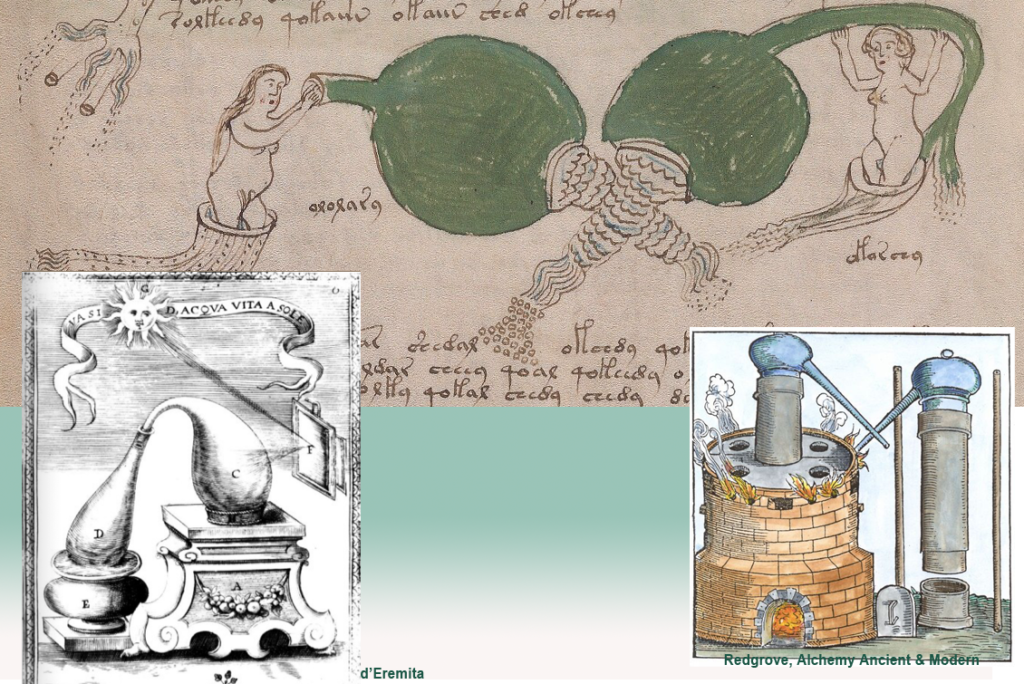
Similarly, the bladder-like shapes at the top of f77v have always reminded me of the she-wolf’s teats in the story of Romulus and Remus, or the chest-of-plenty on Diana of Ephesus (which I have posted in the past), but now I think there might be another explanation:
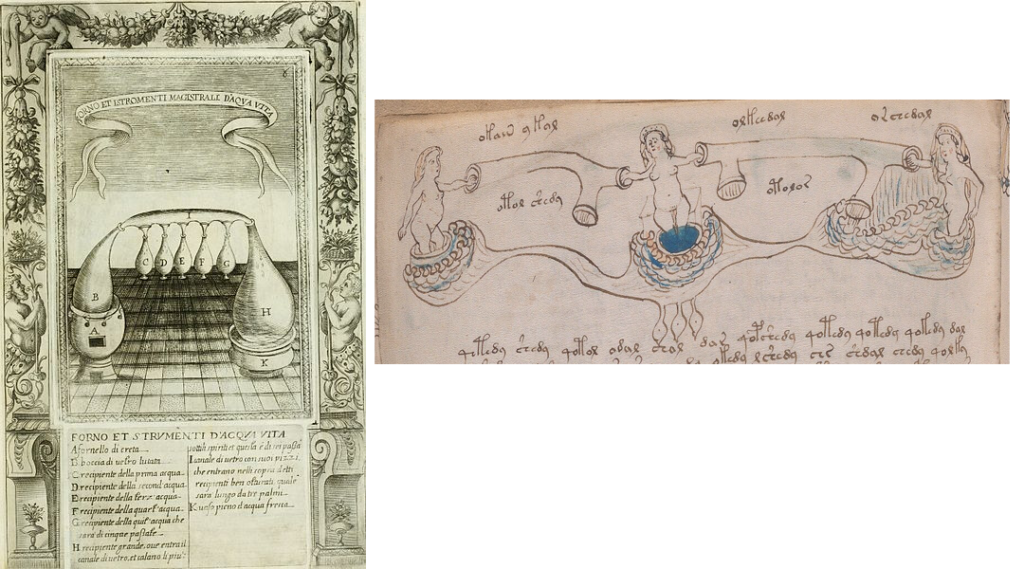
Maybe the row of teats is a row of distillation vessels and the rounded forms left and right are heating vats.
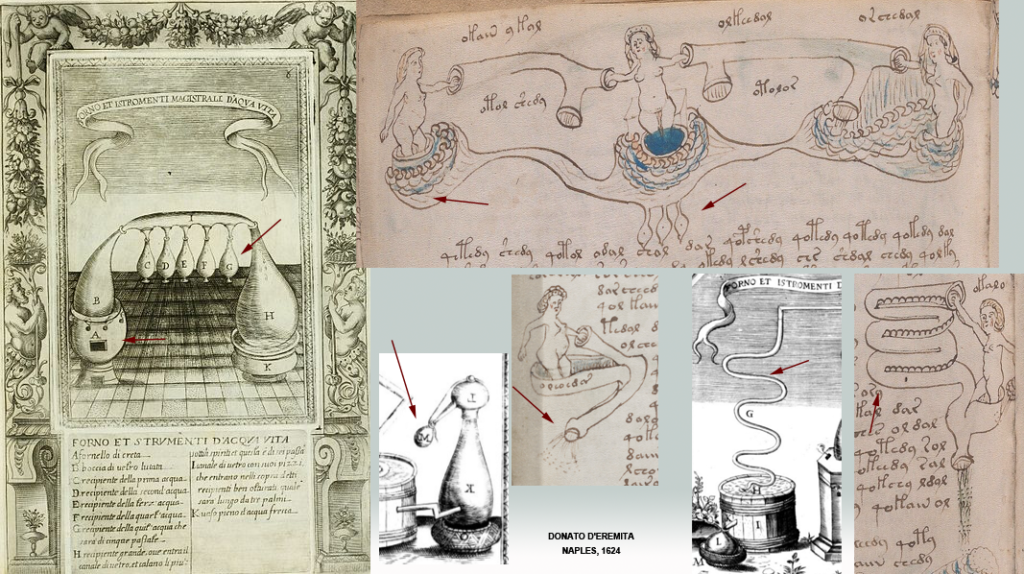
The pipes that connect them are spiritually guided by nymphs (all of alchemy was considered to be under spiritual guidance, hence the heavy use of religious motifs in alchemical drawings). Both magic and alchemy were suspect professions, associated with black arts, so the more religious symbology that was used, the more it legitimized these occupations.
The VMS Rosettes Folio Reprised
On a subject some researchers might not believe is related to distillation processes, I’ve also blogged numerous interpretations for the VMS “map” and I’ve only written up about 20% of the ideas I’ve been working on for years. One that has been lying on the backburner is that the central rosette might be the Tower of Philosophy, related to medieval alchemy. I haven’t posted it mainly because I wasn’t sure, but putting together the distillation process represented by the 77r pipes AND some of the features of the rosettes folio, I feel more confident about this idea than I did before.
I don’t know if anyone has specifically related the central rosette on the VMS “map” folio to the alchemical furnaces of the Tower of Philosophy. Most of the time people mention locations in the middle east (especially Baghdad) or north Africa and some people consider the folio to be a form of portolan.
To me, the central rosette always looked like a sacred place (probably because of the stars and arches and the central position), but I did not specifically associate it with the sacred mountain of the alchemists until today because many places were considered sacred in the middle ages. I think it might represent both sacred mountain and the alchemists’ furnace combined into one drawing. As I have mentioned in previous blogs… the meeting place between terrestrial and cosmological realms.
Here are two examples side-by-side so you can see the similarities. Note that the tower is round, with arches, like the arches in the center of the VMS rosette with the container-like towers. It has an almost onion-dome top and at the base of the image, there are more “towers” that look like pipes:
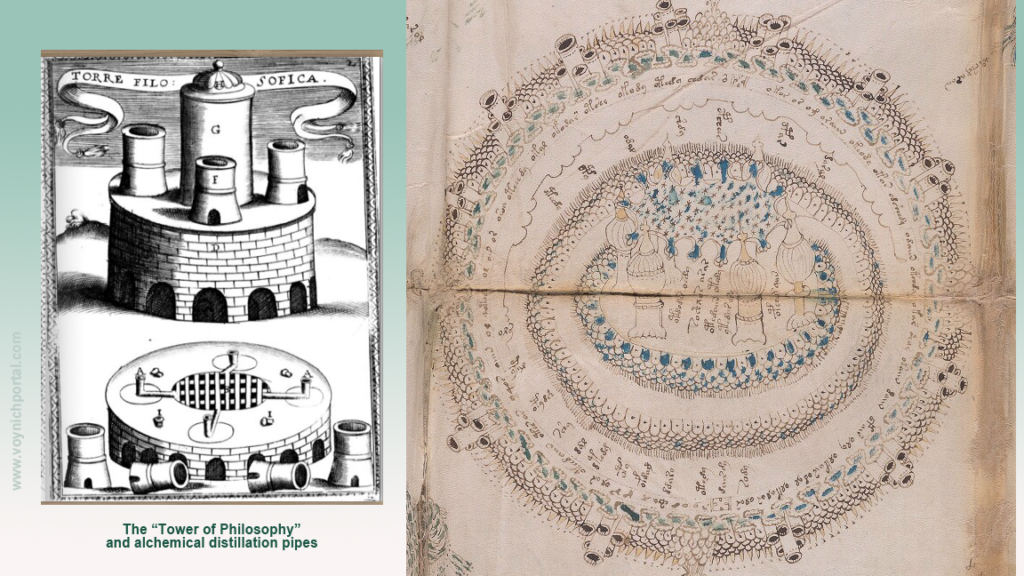
Here is a link to an earlier (15th-century) image of an alchemy furnace with tower-like parts:
Robert Fludd’s images are often posted on the Voynich.ninja forum due to their structural and textural similarities to some of the VMS drawings. They are more sophisticated, and they were created much later than the VMS, but it’s my belief that his ideas were not entirely original, that they derive from older models and thus might have some relevance.
Here is an example that is similar in shape and direction to the general outlay of the rosettes folio. It represents a cosmic battle with demons and archangels attacking and defending the alchemist in the center. Notice the “spewy” things, all drawn in similar ways, but each taking a slightly different form (think of hordes of locusts or bees or frogs as are often mentioned in biblical literature):
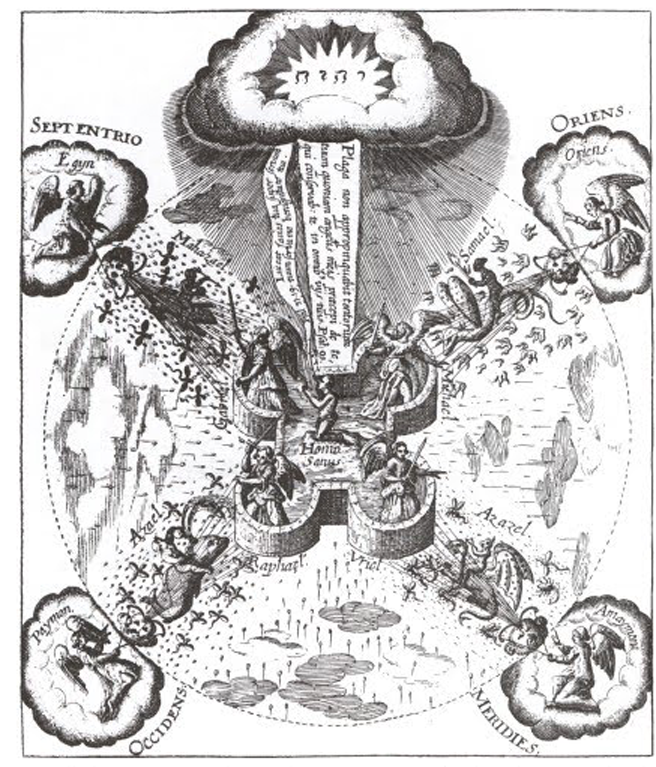
I’ve blogged at length about the “spewy” things in the rosettes folder, never quite knowing what they were, but only that they looked like connections between the inner and outer circles. Maybe, as in Fludd’s engraving, they are pestilences, or a metaphorical reference to the battle between good and evil (with archangels and demons taking sides).
In this Rosicrucian image with alchemical references, notice the tent at the top of the sacred hill (sacred hills are a holdover from Paganism) and the alchemists’ cave below it. The VMS rosettes folio is full of these kinds of structures, almost too many to list in one blog, and MarcoP pointed out that Ellie Velinska had suggested tents for some of the shapes on the rosettes folio. When I took another look, I realized some of the small details that originally made no sense to me might be interpreted as tent flaps. Here is an image of a sacred hill atop an alchemists’ cave (such underground laboratories did actually exist, one was unearthed under a chapel complete with shards of numerous vessels):
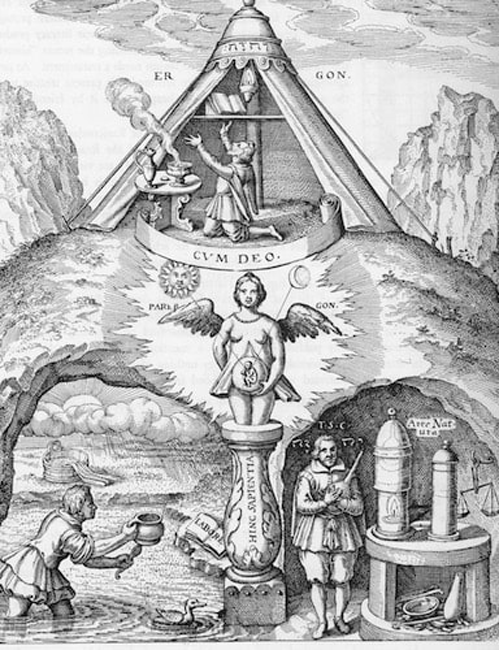
The Many Plant Folios
Distillation has a direct relationship to plants and plants like Centaurea (which I think is depicted fairly accurately on folio 2r) were of specific interest to distillers of alcoholic products, both recreational and medicinal. Tinctures of alcohol not only helped preserve the plants, but they provided concentrated formulas that were sometimes more effective than herbal “simples” (basic plant parts that had not been processed by distillation).
Jakob de Tepenecz, one of the probable owners of the VMS, became quite wealthy from sales of his distilled products. So much so, he could afford to lend money to the emperor himself.
I don’t know if the various sections of the VMS are like separate booklets that have been bound together, or if they were meant to relate to each other, but IF there’s an over-riding theme, then plants would fit right in.
Astrology
Alchemy has also been related to astrology and kabbalah. Besides the three “teats” (see f77v), this hybrid creature has a star on its crown rather than the usual Christian cross. There are also stars-on-sticks radiating from the center. The image further includes references to celestial beings and signs of the zodiac:
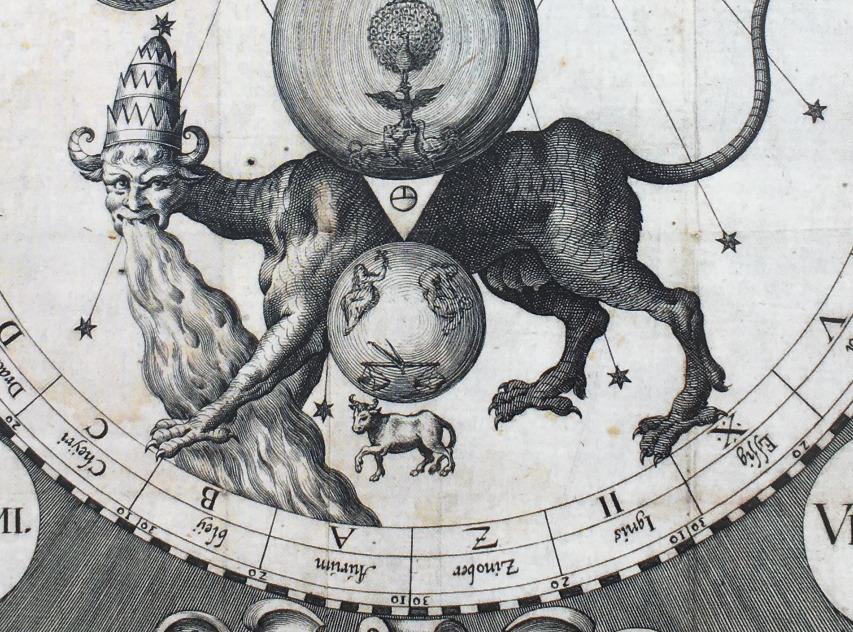
Notice also, in the above image, the inverted T-in-O, a cosmological variant of the T-in-O that is so common in map-related writings.
So maybe the VMS is alchemical after all. After investigating it for a while, I was leaning away from this idea, but a few things clicked when bi3mw revived the ninja thread, so I decided to take another look.
J.K. Petersen
© Copyright Feb. 2020 J.K. Petersen, All Rights Reserved

JKP: Thanks for the good blog ! It gives me new food for thought. Although the mainstream is against an alchemical view of the VMS ( last survey ) it should also be seen from this perspective.
-bi3mw-
To J.K Petersen,
You are right. The VM requires a lot of alchemical wisdom.
I believe that with this page the author wanted to lead the readers to understanding prophesy. The picture in the centre of 77r looks like Delphic E. Research into its meaning led me to Plutarch’s Morelia, where he explains the sacred numbers of 5 and 7.
I suppose the destilation of alcohol could be used for as an analogy of an overactive creative mind at its peak when all the best ideas are coming to the surface.
I understand the top picture on page 77v as continuation of the subject of prophesy with Jesus as a universal symbol for a prophet and three fish-like elements under the female figure as an allusion for the trinity. Do not laugh at the image of Jesus as a female – in this picture he is dealing with the souls which are of female gender.
I found an interesting picture that would help you understand the nymphs in strange containers as well as some other pictures to identify the woman in the Virgo Zodiac. You can contact me at [contact information removed to protect poster’s privacy].